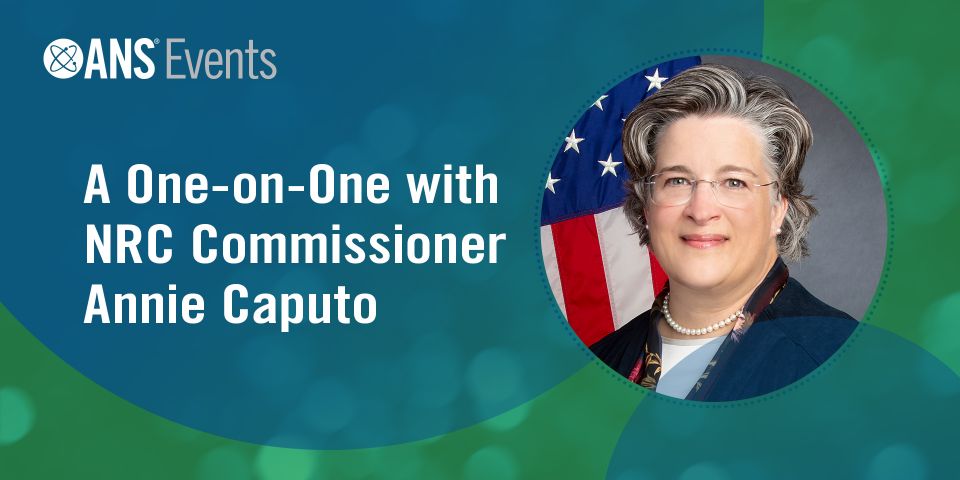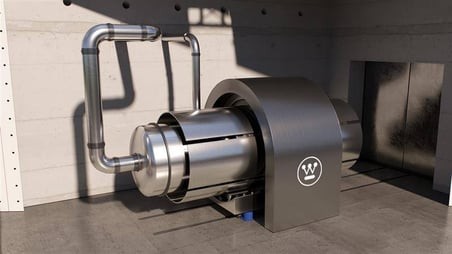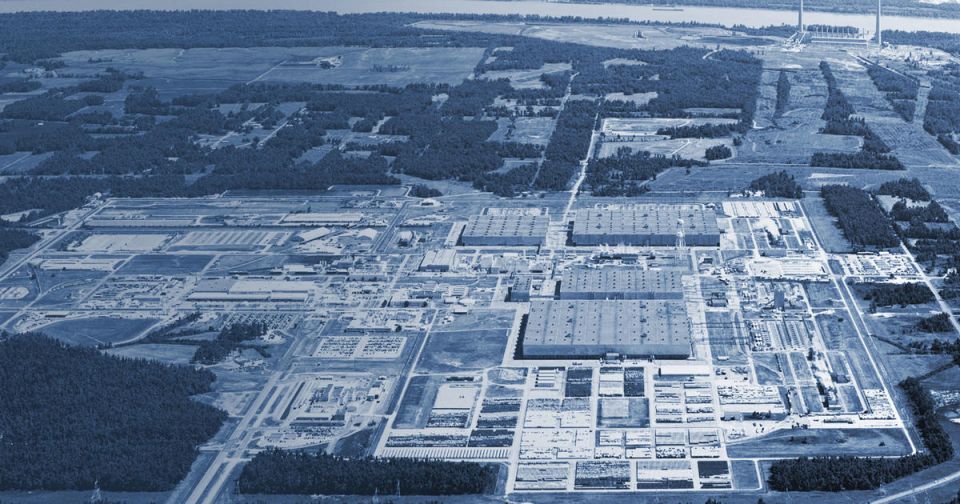Looking back at coverage of TMI—Part 2
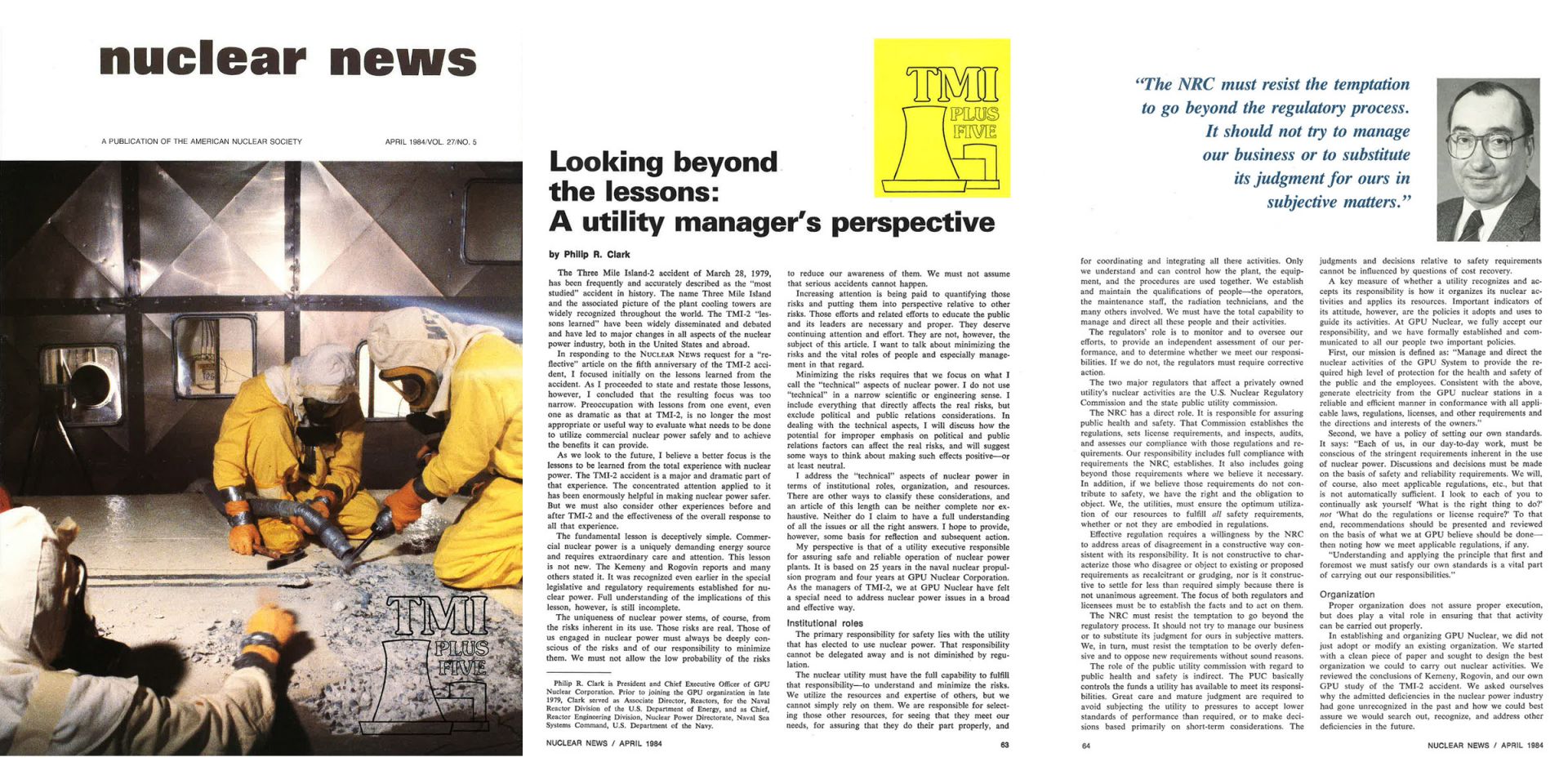
Following up to last week’s #ThrowbackThursday post, we are again turning to the April 1984 issue of Nuclear News, reviewing the coverage in that issue about the five-year anniversary of the Three Mile Island-2 accident.
The special section on the TMI-2 accident, which happened in March 1979, included three stories: one that provided an update on the cleanup and the state of the nuclear plant, another about the future of nuclear power from a regulator’s point of view, and a third that looked at the lessons learned from a utility manager’s perspective. All three articles offered good insight into the TMI-2 accident and the effects it had on the nuclear community. Last week we shared the article from the view of the regulator, and so this week we are sharing the utility’s perspective from five years after the accident.
That perspective was provided by Philip Clark, then the president and chief executive officer of GPU Nuclear Corporation, the former owner of the Three Mile Island nuclear power plant. Prior to joining GPU, Clark had served in multiple positions within the U.S. Navy, an experience that is clear when Clark refers in the article to Admiral Rickover and his philosophy.
Clark introduced his approach to the response to TMI early in the article, he states, “The primary responsibility for safety lies with the utility that has elected to use nuclear power. That responsibility cannot be delegated away and is not diminished by regulation.” This is Clark’s focus throughout the article—how the utility can provide safe and efficient power and improve from the lessons learned following TMI.
Clark’s article is an interesting contrast to that of Nunzio Palladino’s, which was posted on #ThrowbackThursday last week. In his piece, Palladino examines how the Nuclear Regulatory Commission and the Institute of Nuclear Power Operations could provide stringent demands on the industry. At the same time, Clark’s message was, “The NRC must resist the temptation to go beyond the regulatory process. It should not try to manage our business or to substitute its judgment for ours in subjective matters. We, in turn, must resist the temptation to be overly defensive and to oppose new requirements without sound reasons."
Clark added later, “Some of the pressure for independent review seems to arise from a misconception about the utilities—an assumption that they are under financial pressure to do as little as possible. This is fallacious. Experience makes it unmistakably clear that it is to the utilities’ self-interest to design and build nuclear plants properly and operate them safely.”
Clark makes many interesting points in his article that are still relevant today—primarily coming down to the need for open and clear communication and a proper workforce that focuses on character and principles as well as technical knowledge. Clark concludes, “The primary assurance of safe nuclear power is adequate numbers of qualified people managing, supervising, and doing the work. A high level of accountability is necessary and appropriate. Those engaged in nuclear power must accept it. Thus, ‘character,’ the ability to set and adhere to standards despite external pressures, is another requirement for those engaging in nuclear power. We in the industry must find and retain those people of character.”
Clark's full article appears below.
Looking beyond the lessons: A utility manager’s perspective
by Philip R. Clark
The Three Mile Island-2 accident of March 28, 1979, has been frequently and accurately described as the “most studied” accident in history. The name Three Mile Island and the associated picture of the plant cooling towers are widely recognized throughout the world. The TMI-2 “lessons learned” have been widely disseminated and debated and have led to major changes in all aspects of the nuclear power industry, both in the United States and abroad. In responding to the Nuclear News request for a “reflective” article on the fifth anniversary of the TMI-2 accident, I focused initially on the lessons learned from the accident. As I proceeded to state and restate those lessons, however, I concluded that the resulting focus was too narrow. Preoccupation with lessons from one event, even one as dramatic as that at TMI-2, is no longer the most appropriate or useful way to evaluate what needs to be done to utilize commercial nuclear power safely and to achieve the benefits it can provide.
As we look to the future, I believe a better focus is the lessons to be learned from the total experience with nuclear power. The TMI-2 accident is a major and dramatic part of that experience. The concentrated attention applied to it has been enormously helpful in making nuclear power safer. But we must also consider other experiences before and after TMI-2 and the effectiveness of the overall response to all that experience.
The fundamental lesson is deceptively simple. Commercial nuclear power is a uniquely demanding energy source and requires extraordinary care and attention. This lesson is not new. The Kemeny and Rogovin reports and many others stated it. It was recognized even earlier in the special legislative and regulatory requirements established for nuclear power. Full understanding of the implications of this lesson, however, is still incomplete.
The uniqueness of nuclear power stems, of course, from the risks inherent in its use. Those risks are real. Those of us engaged in nuclear power must always be deeply conscious of the risks and of our responsibility to minimize them. We must not allow the low probability of the risks to reduce our awareness of them. We must not assume that serious accidents cannot happen.
Increasing attention is being paid to quantifying those risks and putting them into perspective relative to other risks. Those efforts and related efforts to educate the public and its leaders are necessary and proper. They deserve continuing attention and effort. They are not, however, the subject of this article. I want to talk about minimizing the risks and the vital roles of people and especially management in that regard.
Minimizing the risks requires that we focus on what I call the “technical” aspects of nuclear power. I do not use “technical” in a narrow scientific or engineering sense. I include everything that directly affects the real risks, but exclude political and public relations considerations. In dealing with the technical aspects, I will discuss how the potential for improper emphasis on political and public relations factors can affect the real risks, and will suggest some ways to think about making such effects positive-or at least neutral.
I address the “technical” aspects of nuclear power in terms of institutional roles, organization, and resources. There are other ways to classify these considerations, and an article of this length can be neither complete nor exhaustive. Neither do I claim to have a full understanding of all the issues or all the right answers. I hope to provide, however, some basis for reflection and subsequent action.
My perspective is that of a utility executive responsible for assuring safe and reliable operation of nuclear power plants. It is based on 25 years in the naval nuclear propulsion program and four years at GPU Nuclear Corporation. As the managers of TMI-2, we at GPU Nuclear have felt a special need to address nuclear power issues in a broad and effective way.
lnstitutional roles
The primary responsibility for safety lies with the utility that has elected to use nuclear power. That responsibility cannot be delegated away and is not diminished by regulation.
The nuclear utility must have the full capability to fulfill that responsibility-to understand and minimize the risks. We utilize the resources and expertise of others, but we cannot simply rely on them. We are responsible for selecting those other resources, for seeing that they meet our needs, for assuring that they do their part properly, and for coordinating and integrating all these activities. Only we understand and can control how the plant, the equipment, and the procedures are used together. We establish and maintain the qualifications of people-the operators, the maintenance staff, the radiation technicians, and the many others involved. We must have the total capability to manage and direct all these people and their activities.
The regulators’ role is to monitor and to oversee our efforts, to provide an independent assessment of our performance, and to determine whether we meet our responsibilities. If we do not, the regulators must require corrective action.
The two major regulators that affect a privately owned utility’s nuclear activities are the U.S. Nuclear Regulatory Commission and the state public utility commission. The NRC has a direct role. It is responsible for assuring public health and safety. That Commission establishes the regulations, sets license requirements, and inspects, audits, and assesses our compliance with those regulations and requirements.
Our responsibility includes full compliance with requirements the NRC establishes. It also includes going beyond those requirements where we believe it necessary. In addition, if we believe those requirements do not contribute to safety, we have the right and the obligation to object. We, the utilities, must ensure the optimum utilization of our resources to fulfill all safety requirements, whether or not they are embodied in regulations.
Effective regulation requires a willingness by the NRC to address areas of disagreement in a constructive way consistent with its responsibility. It is not constructive to characterize those who disagree or object to existing or proposed requirements as recalcitrant or grudging, nor is it constructive to settle for less than required simply because there is not unanimous agreement. The focus of both regulators and licensees must be to establish the facts and to act on them.
The NRC must resist the temptation to go beyond the regulatory process. It should not try to manage our business or to substitute its judgment for ours in subjective matters. We, in turn, must resist the temptation to be overly defensive and to oppose new requirements without sound reasons.
The role of the public utility commission with regard to public health and safety is indirect. The PUC basically controls the funds a utility has available to meet its responsibilities. Great care and mature judgment are required to avoid subjecting the utility to pressures to accept lower standards of performance than required, or to make decisions based primarily on short-term considerations. The judgments and decisions relative to safety requirements cannot be influenced by questions of cost recovery.
A key measure of whether a utility recognizes and accepts its responsibility is how it organizes its nuclear activities and applies its resources. Important indicators of its attitude, however, are the policies it adopts and uses to guide its activities. At GPU Nuclear, we fully accept our responsibility, and we have formally established and communicated to all our people two important policies.
First, our mission is defined as: “Manage and direct the nuclear activities of the GPU System to provide the required high level of protection for the health and safety of the public and the employees. Consistent with the above, generate electricity from the GPU nuclear stations in a reliable and efficient manner in conformance with all applicable laws, regulations, licenses, and other requirements and the directions and interests of the owners.”
Second, we have a policy of setting our own standards. It says: “Each of us, in our day-to-day work, must be conscious of the stringent requirements inherent in the use of nuclear power. Discussions and decisions must be made on the basis of safety and reliability requirements, We will, of course, also meet applicable regulations, etc., but that is not automatically sufficient. I look to each of you to continually ask yourself ‘What is the right thing to do?’ not ‘What do the regulations or license require?’ To that end, recommendations should be presented and reviewed on the basis of what we at GPU believe should be done then noting how we meet applicable regulations, if any.
“Understanding and applying the principle that first and foremost we must satisfy our own standards is a vital part of carrying out our responsibilities.”
Organization
Proper organization does not assure proper execution, but does play a vital role in ensuring that that activity can be carried out properly.
In establishing and organizing GPU Nuclear, we did not just adopt or modify an existing organization. We started with a clean piece of paper and sought to design the best organization we could to carry out nuclear activities. We reviewed the conclusions of Kemeny, Rogovin, and our own GPU study of the TMI-2 accident. We asked ourselves why the admitted deficiencies in the nuclear power industry had gone unrecognized in the past and how we could best assure we would search out, recognize, and address other deficiencies in the future.
The key concepts we decided should be included in the design of the organization are as follows:
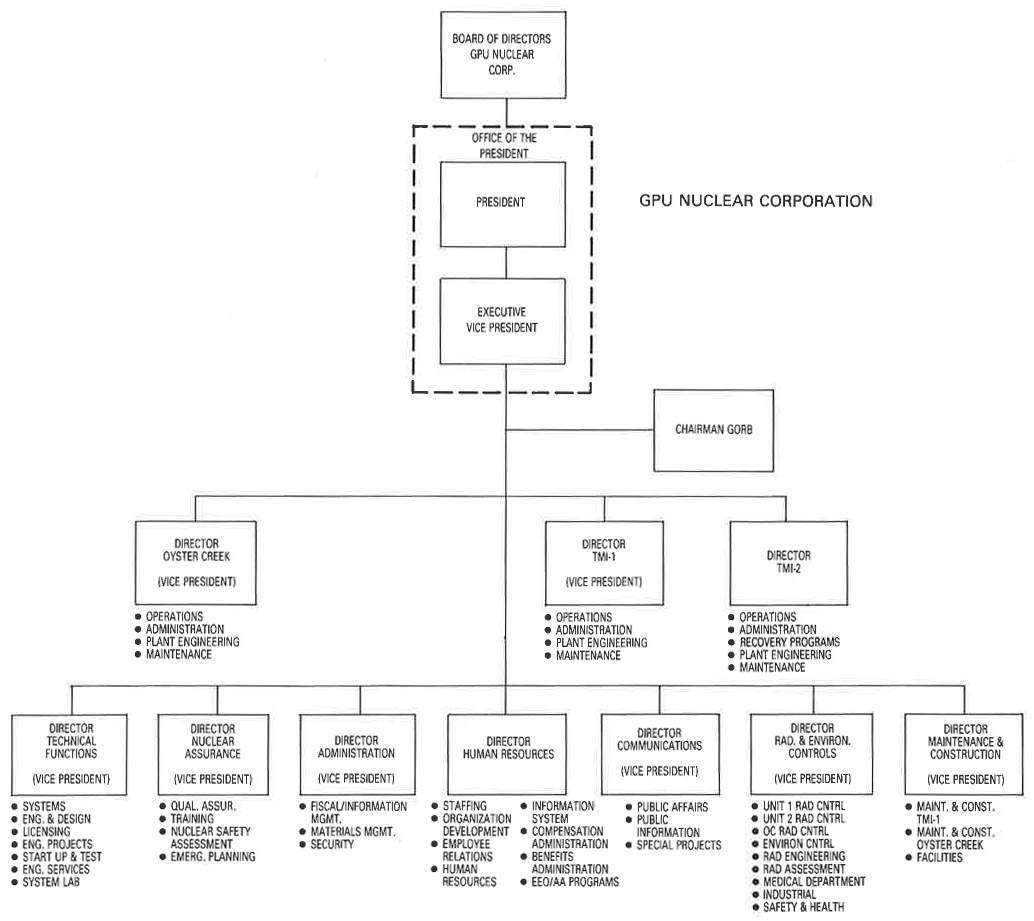
Figure 1: The GPU Nuclear Organization
1. An integrated organization having full responsibility and authority for all aspects of nuclear activities and having no other responsibilities.
The establishment of GPU Nuclear Corporation was announced in January 1980 by William G. Kuhns, the Chairman of the Board and Chief Executive Officer of General Public Utilities Corporation. The basic structure was defined and put in place in September 1980. It was confirmed and institutionalized in January 1982, when GPU Nuclear began functioning as a corporation and was formally licensed by the NRC as the operator (but not the owner) of the TMI-I, TMI-2, and Oyster Creek nuclear generating stations.
Today, we have what we consider the appropriate separation of nuclear activities from the other activities of the General Public Utilities system. While GPU Nuclear is a subsidiary of General Public Utilities, we have a separate board of directors. That board has four directors from outside the system and seven directors from within the system. The chairman himself is an outside director. The other three outside directors constitute a Nuclear Safety and Compliance Committee. This committee is somewhat analogous to the more familiar financial audit committee of many boards, but its purpose is to ensure adequate management attention to safety. It will have independent visibility into the operations by virtue of having its own staff.
GPU Nuclear and all of its officers (including the CEO) are assigned full time to nuclear activities. Thus, there is only one objective and one consistent set of standards for all of our work.
2. Full-time attention to each of the major disciplines involved.
Figure 1 shows the basic organization of GPU Nuclear. We have a division devoted to operating and maintaining each of the nuclear plants, with the plant division director located at the site. He has within his division the engineering support needed for day-to-day operations. He does not, however, have primary responsibility for and control of the design of the plant or the technical adequacy of its operating procedures.
The Plant Directors are aided by six Support Divisions and a Human Resources group. This allows them to concentrate on the demanding requirements of operation and maintenance and permits full-time independent expert attention to the other activities as well.
- The Director of Technical Functions is responsible for the technical adequacy of all nuclear activities. He has control of the plant configuration.
- The Director of Radiological and Environmental Controls sets the standards and requirements in these areas and conducts the necessary monitoring.
- The Director of Nuclear Assurance is responsible for Training, Quality Assurance, and Emergency Preparedness. His staff provides full-time professional attention to these vital areas to help ensure that they are not neglected and do not take second place to operating requirements. The Nuclear Assurance Division also includes the Nuclear Safety Assessment Department (discussed in greater detail below).
- The Director of Maintenance and Construction establishes methods and standards for maintenance and modification activities and carries out most of such work.
- The Director of Administration is responsible for security as well as budgeting and materials management.
- The Director of Communications has a staff of 35 people and is responsible to provide full, prompt, and accurate information to the public, government officials, media, and our own employees.
- The Director of Human Resources is responsible for the vital activities of personnel recruiting, retention, and development.
3. Extensive cross-checking and independent review of activities within the organization to help ensure that all activities are carried out properly.
In addition to the normal quality assurance activities, we provide:
- Quality assurance monitoring of ongoing activities. This is in addition to normal QA inspections and audits.
- An independent Nuclear Safety Assurance Department. This group has both a headquarters staff and a full-time group at each site. These people are responsible for assessing all activities (and anything we may not be doing but should do) to identify ways to ensure safety. Members of the group have few assigned duties, are in addition to the safety review requirements of our license, and thus are free to think broadly about what really contributes to safety.
- A radiological assessor for each site. He reports to the Director of Radiological and Environmental Controls and is responsible for monitoring all activities to identify radiological deficiencies.
- A General Office Review Board (GORB) for each plant reporting to the Office of the President. This board is not required by our license. It has senior experienced members, many from outside the GPU system. It is active, meeting six times a year for each plant. It has subcommittees and staff support. Its charter is to foresee potentially significant nuclear or radiation safety issues and make recommendations to the Office of the President. These recommendations are responded to formally. The board has direct access to GPU Nuclear’s Board of Directors and meets with them periodically.
In addition to these overview activities, we have established mechanisms to allow any individual to report quality, safety, or radiological deficiencies or concerns. If desired, such concerns can be reported to a corporate ombudsman with an assurance of confidentiality.
Resources
In view of the fundamental responsibility of the utility, I believe the single most significant measure of resources is the staff within the utility devoted full time to its nuclear power activities. There are many ways to look at these resources. Three of the most meaningful are:
Total company personnel applied. Today, GPU Nuclear has more than 900 of its own people applied full time to operating and supporting TMI-I. There are about 1000 supporting Oyster Creek. More than 700 of these people are stationed at each site. For comparison, in March 1979, Metropolitan Edison had a total of about 320 people applied to TMI-I, of which about 260 were at the site. TMI-2 is a special case involving many activities not normal for a utility, and we therefore have a greater degree of involvement by our prime contractor, Bechtel. Even so, there are more than 550 GPU Nuclear people applied to TMI-2.
On-shift staffing. These are the people immediately available to respond to an emergency. We cannot assume that an emergency will occur during a weekday. At TMI-I, we have a staff of 23 on-shift at all times. This includes two Senior Control Room Operators, three Reactor Operators, six Auxiliary Operators, a Shift Technical Advisor, a Radiation Control foreman, two radiation technicians, two chemistry technicians, and a maintenance crew of six. In March 1979, MeI Ed had an on-shift crew of 11. There is also an on-shift security force.
Technical resources. Today, GPU Nuclear has approximately 500 technical degreed professionals applied to TMI-I and Oyster Creek. About 300 of them are in the Technical Functions Division, while the rest are spread throughout the other divisions. These professionals have a total of almost 4000 years of professional experience, of which about 2800 years are in nuclear power.
Harder to quantify, but very important, is the training of these people. We have adopted a six-shift rotation for GPU Nuclear’s shift people to allow ample time for training and retraining. At TMI-I, the operators, shift technical advisors, and maintenance people are on six shifts. At Oyster Creek, we are building up to that situation.
While we must and will continue to learn how best to distribute and apply our resources and make them more effective, I believe we have achieved approximately the right level. In fact, as the backlog of lessons learned is worked off and our organization matures, some reduction in overall numbers and some re-allocation among the Divisions can be expected.
Last year, in the face of some very strong skepticism, Mr. Kuhns asked Adm. Hyman G. Rickover to evaluate the organization and senior people of GPU Nuclear in anticipation of the restart of TMI-I. Many thought that the admiral, known for his independence, exacting standards, and forceful criticism, would be a negative for Three Mile Island. As it turned out, such was not the case.
Adm. Rickover and a team of his choosing spent two and a half months on the matter. His report said that GPU Nuclear has the “management and integrity to safely operate” TMI-I. More importantly, the admiral defined some criteria, or principles, for the operation of nuclear power plants generally.
“Although commercial nuclear plants and Naval nuclear plants differ in many ways,” Rickover wrote in the preface to his report, “they do not differ in the underlying principles which make for safe operation. These apply equally to both Since nuclear power is clearly here to stay, such attitudes and principles must, in my opinion, become industry’s standard.”
Stated in the form of management objectives, Rickover’s principles for sound nuclear power operations are:
- Require rising standards of adequacy.
- Be technically self-sufficient.
- Face facts.
- Respect even small amounts of radiation.
- Require relentless training.
- Require adherence to the concept of total responsibility.
- Develop the capacity to learn from experience.
“These principles,” Rickover noted, “express attitudes and beliefs. They acknowledge the complex technology. They recognize that safe nuclear operation requires painstaking care. They declare that a nuclear management must be responsible---all the time. Although easily stated and readily defined, these principles are exceedingly demanding of a management which chooses to adopt and follow them. If management has chosen such a course, it will lead to a competent and dependable operation.”
While Rickover focused his assessment on TMI-I today and did not revisit the TMI-2 accident as such, his report represents a kind of capstone to the Kemeny and Rogovin reports and the other investigations of the Unit 2 accident. Starting, he stressed, with senior management, due management diligence applied through an organization broad and deep enough to be fully effective is critical to safe nuclear operations.
Realistically, the admiral said, the test is not whether a nuclear management achieves perfection, “Since we are dealing with people and machines which cannot be made perfect, it is important to recognize that mistakes will be made.” The standard, the admiral emphasized, is whether an organization has “a capacity to acknowledge mistakes and to search out and correct their underlying causes.” We had believed that GPU Nuclear’s organization and people were sound. The admiral’s evaluation confirmed that belief. While the details of organization can and should vary among utilities, the principles described and illustrated above are, I believe, valid and applicable to all.
More lessons to be learned
I said at the beginning of this article that full understanding of the implications of nuclear power is still incomplete. Let me now turn to some examples.
I believe there are two major areas in which fundamental reassessment and change are still needed, These are lessons to be learned, not from experiences at the plant, but from how the industry and its regulators have responded to the experience with nuclear power.
The first is how to deal with mistakes in ways that can truly contribute to safety. This problem exists not only within the utility, but also in the response of the NRC and others. There will always be mistakes. Nuclear plants are designed to accept failures and mistakes without adversely affecting safety. From a design standpoint, we must try to minimize the potential for mistakes and maximize the ability of the plant to tolerate them without harm to the public or our workers,
From an operating standpoint, each mistake must be identified and steps taken to prevent recurrences. That often means taking disciplinary action, including discharge, We have been moving steadily toward demanding accountability and applying appropriate discipline.
It is essential, however, to be able to get all the facts and to get them promptly. Getting the facts will inevitably show areas where individuals did not fully understand what was expected of them-areas that need to be addressed, not merely by disciplining the individuals involved, but, in some cases, by disciplining the supervisors or management and, in other cases, by providing better or clearer policies, procedures, or training,
Excessive emphasis on disciplining individuals or unfair discipline applied on the basis of incomplete understanding of what really happened can result in pressures on individuals that inhibit the full, free, and open communication needed to assure that mistakes are promptly and fully reported and acknowledged so that they can be corrected.
Getting all the facts quickly can be impeded by the threat of civil penalties or criminal prosecution of individuals. Such action is warranted in some cases, but it has a price. While investigations aimed at assessing such penalties are under way, they impede the efforts of the utilities and the NRC to get the facts they need to prevent further problems.
An extreme case involves the so-called Hartman allegations at TMI-2. Those allegations involve actions in 1978 and early 1979. Because of the potential for criminal indictment of individuals, we have still, five years later, been unable to interview many of the people involved because they were advised by their counsel not to discuss the matter.
This complex question of how best to enhance safety while protecting individual rights and punishing wrongdoing requires a careful assessment on an overall basis. To date, it has been dealt with too much on an ad hoc basis. A recent decision by the NRC to review this matter is overdue but welcome.
The second area is the need to address safety issues on the basis of facts-not perceptions and opinions-and separately from political factors. Far too often, discussions of technical matters are intermingled with references to how the actions or decisions will be perceived or misunderstood.
While political factors and public perceptions are important, mixing them with technical matters leads to poor decisions. We and our regulators must strive to determine technical facts and reach sound technical conclusions, and only then, separately and openly, address the other factors.
Much progress has been made in the last five years. All of us can take satisfaction in that. Commercial nuclear power is safer today than before. The overall safety record is good. There is much to do, however--much can be learned from the total experience to date and from our continuing experience.
Last summer, we conducted a symposium among senior company people plus some outsiders to assess whether we had fully learned all the lessons of TMI-2, Overall, we concluded that the lessons were recognized and had been or were being adequately addressed. Our conclusion was, however, that we must focus not on how far we had come, but on how far we have yet to go and how to preserve our gains.
Conclusion
In discussing resources above, I defined them in terms of people. That is the vital ingredient for safely using nuclear power. The long-term strategies for nuclear power must recognize this. It will not be enough to establish adequate staffing levels and training programs. It must be made attractive and rewarding to hold those jobs and possible to do them in a manner satisfying to the individuals.
There is a great deal of attention being paid today to the use of independent review. Much of this is proper and helpful. I discussed above the checks and balances and independent safety reviews established in GPU Nuclear. We believe they are needed, Independent review, however, can be overdone and can detract from safety. Every review places a demand on those doing the work.
There is a well-established axiom in quality assurance that “you can’t inspect quality into the job.” Neither can you review quality into the job. The primary assurance of safe nuclear power is adequate numbers of qualified people managing, supervising, and doing the work.
Some of the pressure for independent review seems to arise from a misconception about the utilities-an assumption that they are under financial pressure to do as little as possible. This is fallacious. Experience makes it unmistakably clear that it is to the utilities’ self-interest to design and build nuclear plants properly and operate them safely.
It is a tough, demanding job. There is an unprecedented level of scrutiny of nuclear power and the people engaged in it. There is also a high, perhaps unprecedented, level of external interest and pressure to enforce individual personal liability for mistakes. A high level of accountability is necessary and appropriate. Those engaged in nuclear power must accept it, Thus, “character,” the ability to set and adhere to standards despite external pressures, is another requirement for those engaging in nuclear power.
We in the industry must find and retain those people of character. Those outside the industry--regulators, political leaders, intervenors, and the public--must avoid creating an environment in which the rewards go to advisers, reviewers, and critics, but in which there is no reward for doing a tough but necessary job. To do so would be counter to safety.
Philip R. Clark was then president and chief executive officer of GPU Nuclear Corporation. Prior to joining the GPU organization in late 1979, Clark served as associate director, Reactors, for the Naval Reactor Division of the Department of Energy, and as Chief, Reactor Engineering Division, Nuclear Power Directorate, Naval Sea Systems Command, Department of the Navy.



